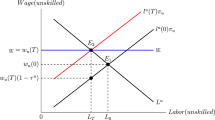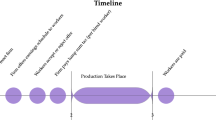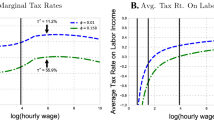Abstract
This paper concerns optimal income taxation in a two-type model extended to allow for social interaction and social norms in the labor market. One norm refers to “normal behavior” with respect to work hours (the hours of work norm), whereas another means that “one should earn one’s living by working” (the participation norm). The results show how the hours of work norm gives rise to a corrective motive for using income taxation. We also show how the interaction between the hours of work norm and the private incentive to participate in the labor market (which reflects the participation norm) gives rise to an employment motive for using the income tax.
Similar content being viewed by others
References
Abel, A. B. (2005). Optimal taxation when consumers have endogenous benchmark levels of consumption. Review of Economic Studies, 72, 21–42.
Akerlof, G. (1980). A theory of social custom, of which unemployment may be one consequence. Quarterly Journal of Economics, 94, 749–775.
Aronsson, T., & Sjögren, T. (2003). Income taxation, commodity taxation and provision of public goods under labor market imperfections. Finanzarchiv, 59, 347–370.
Aronsson, T., & Sjögren, T. (2004). Is the optimal labor income tax progressive in a unionized economy? Scandinavian Journal of Economics, 106, 661–675.
Aronsson, T., & Johansson-Stenman, O. (2008). When the Joneses’ consumption hurts: optimal public good provision and nonlinear income taxation. Journal of Public Economics, 92, 986–997.
Aronsson, T., Blomquist, S., & Sacklen, H. (1999). How to identify interdependent behaviour in an empirical model of labor supply. Journal of Applied Econometrics, 14, 607–626.
Bernheim, D. (1994). A theory of conformity. Journal of Political Economy, 102, 841–877.
Blomquist, S. (1993). Interdependent behavior and the effect of taxes. Journal of Public Economics, 51, 211–218.
Boskin, M. J., & Sheshinski, E. (1978). Individual welfare depends upon relative income. Quarterly Journal of Economics, 92, 589–601.
Bowles, S., & Gintis, H. (2000). Reciprocity, self-interest and the welfare state. Nordic Journal of Political Economy, 26, 33–53.
Bruvoll, A., & Nyborg, K. (2004). The cold shiver of not giving enough: On the social costs of recycling campaigns. Land Economics, 80, 540–549.
Carlsson, F., Johansson-Stenman, O., & Martinsson, P. (2007). Do you enjoy having more than others? Survey evidence of positional goods. Economica, 74, 586–598.
Falk, A., & Knell, M. (2004). Choosing the Joneses: endogenous goals and reference standards. Scandinavian Journal of Economics, 106, 417–435.
Fuest, C., & Huber, B. (1997). Wage bargaining, labor-tax progression, and welfare. Journal of Economics, 66, 127–150.
Howarth, R. B. (2006). Optimal environmental taxation under relative consumption effects. Ecological Economics, 58, 209–219.
Jakee, K., & Sun, G.-Z. (2005). External habit formation and dependency in the welfare state. European Journal of Political Economy, 21, 83–98.
Lindbeck, A. (1995). Welfare state disincentives with endogenous habits and norms. Scandinavian Journal of Economics, 97, 477–494.
Lindbeck, A., Nyberg, S., & Weibull, J. (1999). Social norms and economic incentives in the welfare state. Quarterly Journal of Economics, 114, 1–35.
Lindbeck, A., Nyberg, S., & Weibull, J. (2003). Social norms and welfare state dynamics. Journal of the European Economic Association, 1, 533–542.
Persson, M. (1995). Why are taxes so high in egalitarian societies? Scandinavian Journal of Economics, 97, 569–580.
Solnick, S., & Hemenway, D. (1998). Is more always better?: A survey on positional concerns. Journal of Economic Behavior and Organization, 37, 373–383.
Stern, N. H. (1982). Optimum taxation with errors in administration. Journal of Public Economics, 17, 181–211.
Stiglitz, J. E. (1982). Self-selection and Pareto efficient taxation. Journal of Public Economics, 17, 213–240.
Wendner, R. (2005). Frames of reference, the environment and efficient taxation. Economics of Governance, 6, 13–31.
Woittiez, I., & Kapteyn, A. (1998). Social interaction and habit formation in a model of female labor supply. Journal of Public Economics, 70, 185–205.
Author information
Authors and Affiliations
Corresponding author
Rights and permissions
About this article
Cite this article
Aronsson, T., Sjögren, T. Optimal income taxation and social norms in the labor market. Int Tax Public Finance 17, 67–89 (2010). https://doi.org/10.1007/s10797-008-9100-1
Published:
Issue Date:
DOI: https://doi.org/10.1007/s10797-008-9100-1




